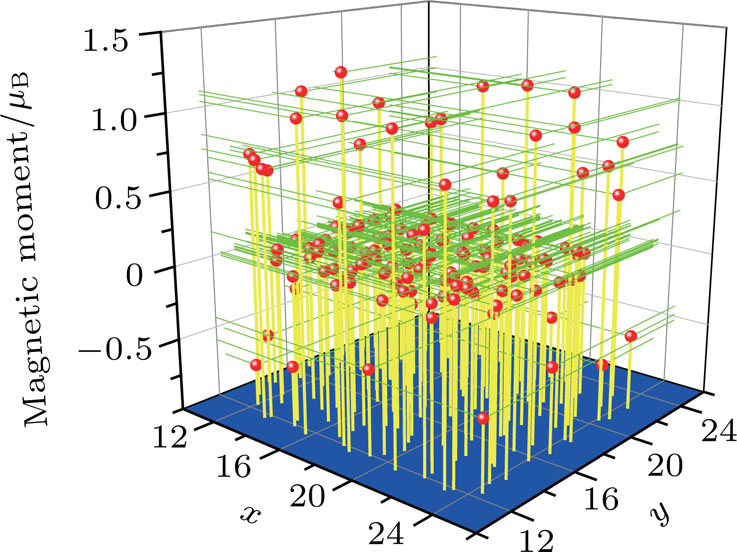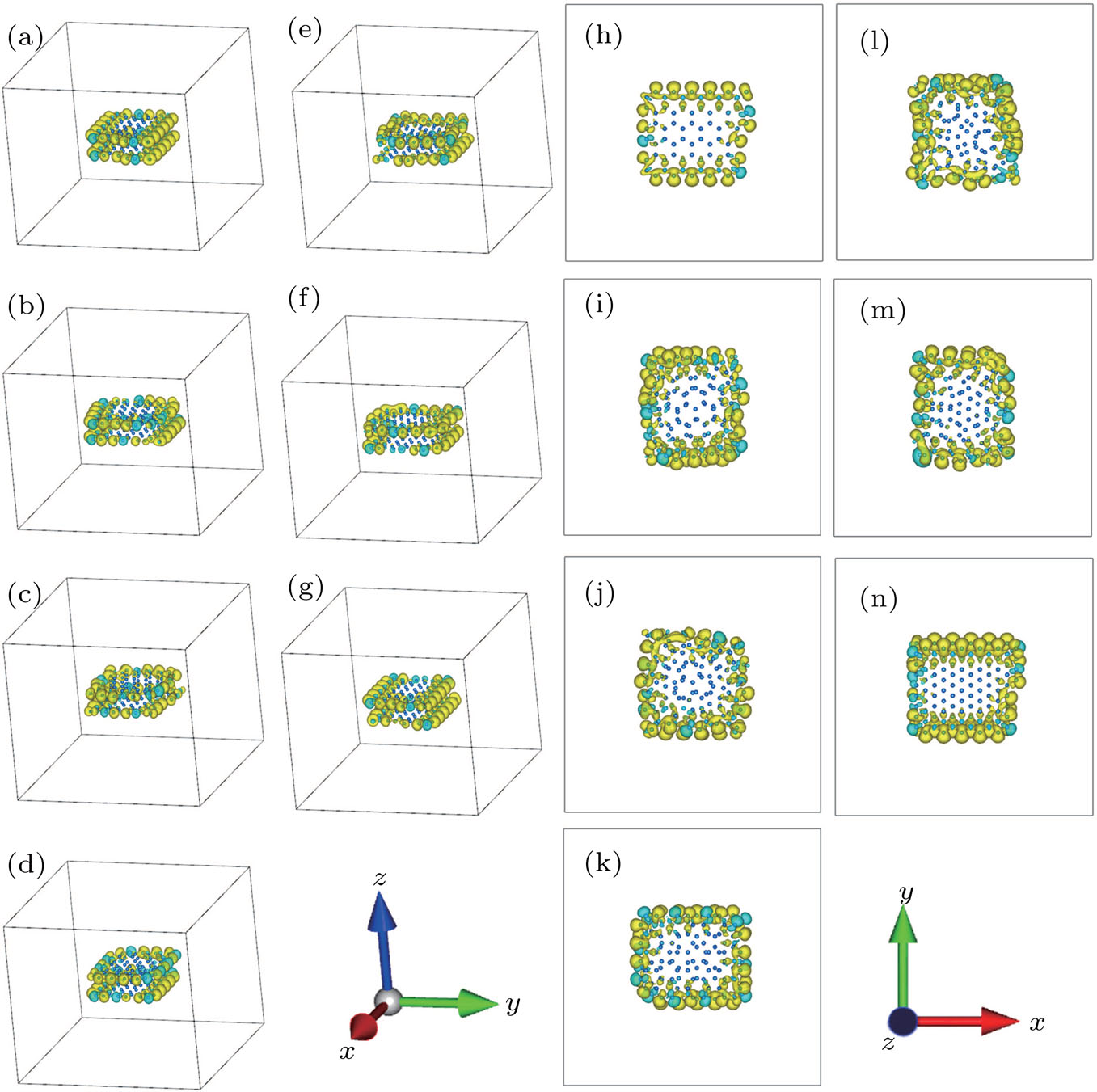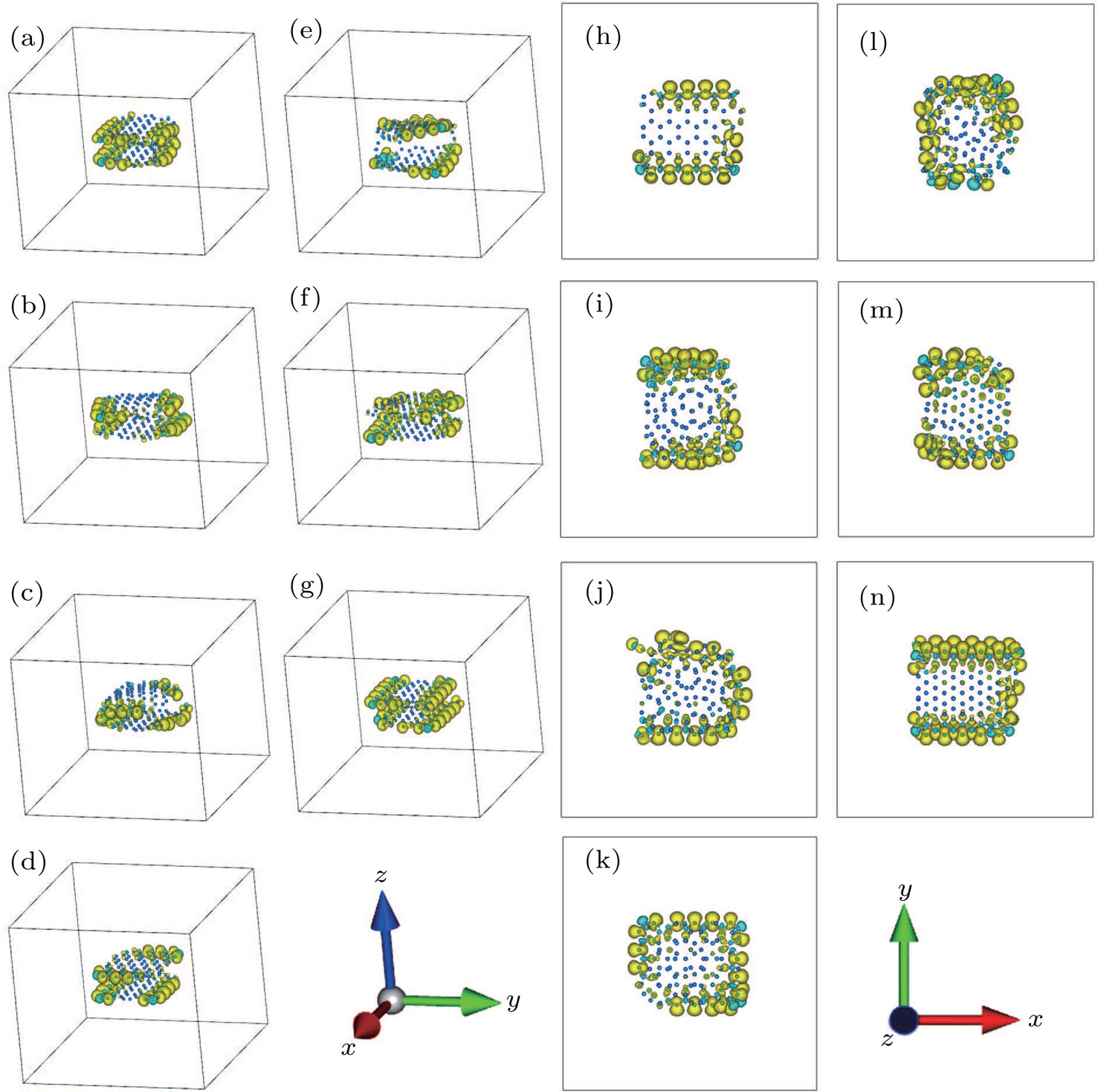† Corresponding author. E-mail:
Project supported by the National Natural Science Foundation of China (Grant Nos. 11374174, 51390471, 51527803, and 51701143), the National Basic Research Program of China (Grant No. 2015CB654902), the National Key Research and Development Program of China (Grant No. 2016YFB0700402), the Foundation for the Author of National Excellent Doctoral Dissertation, China (Grant No. 201141), the Tianjin Municipal Education Commission, China, the Tianjin Municipal Science and Technology Commission, China, and the Fundamental Research Fund of Tianjin University of Technology. This work made use of the resources of the National Center for Electron Microscopy in Beijing and Tsinghua National Laboratory for Information Science and Technology.
Bilayer graphene quantum dots with rotational stacking faults (RSFs) having different rotational angles were studied. Using the first-principles calculation, we determined that these stacking faults could quantitatively modulate the magnetism and the distribution of spin and energy levels in the electronic structures of the dots. In addition, by examining the spatial distribution of unpaired spins and Bader charge analysis, we found that the main source of magnetic moment originated from the edge atoms of the quantum dots. Our research results can potentially provide a new path for producing all-carbon nanodevices with different electrical and magnetic properties.
Graphene has attracted the interest of researchers worldwide due to its unique properties, while numerous experimental and theoretical studies have been conducted on its applications in the fields of electronics,[1] optoelectronics,[2] photonics,[3] photovoltaics,[4] mechanics,[5] quantum interference,[6] quantum computation,[7] field emission,[8] fluorescence emission,[9] and secondary electron emission.[10,11] It has been found that defects such as point defects,[12] line defects,[13] and grain boundaries[14] can modulate the electronic structure and magnetic properties of graphene. Therefore, it is very promising to use defects to modulate the properties of graphene and, thus, develop various functional devices.[15–17]
Rotational stacking faults (RSFs) are a type of intrinsic defects that commonly occur in layered materials, such as folded monolayer and few-layer two-dimensional molybdenum disulfide[18–20] and graphene.[21,22] An RSF refers to the deviation from the standard sequence of the stacking order among layers in a layered material, and a relative rotation exists between the layers. Studies have already shown that RSFs can change the electronic structure of layered materials.[21–24] In particular, bilayer graphene with a small rotation angle, known as the magic angle, has unconventional superconductivity.[25,26] However, the influence of RSFs on the magnetic and electronic properties of bilayer graphene quantum dots has not been fully studied.
In this work, we employed the first-principles calculation based on density functional theory (DFT) to study the electrical and magnetic properties of bilayer graphene quantum dots with RSFs having different rotational angles. Our results show that these bilayer graphene quantum dots have different magnetic moments, energy levels, and spin distributions. For example, some graphene quantum dots have spin up in both highest occupied molecular orbital (HOMO) and lowest unoccupied molecular orbital (LUMO), while some have spin down and up. These results indicated that RSFs with different rotational angles can be used to modulate the magnetism and electronic structures of bilayer graphene quantum dots, aiding us to develop various new electronic, magnetic, and spintronic devices.
The software used in this study for the first-principles calculation was the Vienna ab initio simulation package (VASP).[27] The methodology used was the projector augmented wave (PAW)[28] method. The exchange correlation energy was evaluated using the Perdew–Burke–Ernzerhof (PBE) formulation,[29] a derivation of the generalized gradient approximation. The cutoff kinetic energy of the plane wave basis set was set at 400 eV. The convergence threshold energy was set to 10−5 eV. The supercell used in the calculation had a vacuum layer of at least 20 Å in all three directions which was large enough to avoid interactions between adjacent bilayer graphene quantum dots. Therefore, only a k-point was used to express the Brillouin zone. To determine the ground states of the bilayer graphene quantum dots, the spin polarization and non-spin polarization of all models were also determined. The total energy was compared, and the lower energy state was selected as the ground state for the following calculation.
Because many RSF rotational angles were found in the experiments,[18–21,38,39] we selected bilayer graphene quantum dots with RSF angles of 0°, 8.95°, 19.11°, 30°, 40.89°, 51.05°, and 60° as examples for calculations. The total number of atoms was 138, which was the same as that in a previous work on molybdenum disulfide quantum dots.[40] Among them, the bilayer graphene quantum dots with the 60° RSFs were actually in the most stable AB stacking form. Figure
We first performed calculations for the unrelaxed models. The total energy differences between the spin polarized state and the non-spin polarized state of the seven models in Fig. 







Figure
In addition, we also observed that the LUMO–HOMO energy gaps of these seven models varied in magnitude, and were 0.0009 eV (0°), 0.0128 eV (8.95°), 0.0094 eV (19.11°), 0.0108 eV (30°), 0.0028 eV (40.89°), 0.0044 eV (51.05°), and 0.0271 eV (60°), respectively. These differences implied that the electron conduction of these seven quantum dots showed different responses to an external electric field. Their ability to generate photons and interact with photons also differed.[39] This is advantageous for designing and producing various all-carbon electronic and optoelectronic functional devices.
We then performed DFT calculations for the relaxed models and found that the results were very similar to those of the unrelaxed models, as shown in Figs. 






To better understand the effect of different RSF rotational angles on the magnetic moment and energy gap of bilayer graphene quantum dots, we plotted the magnetic moment and energy gap of unrelaxed and relaxed models together as a function of the rotational angle, as shown in Fig.
To explore the source of the magnetic moments of these models, we focused on the bilayer graphene quantum dots with a 30° RSF rotational angle as an example and determined the magnetic moment of each atom in the quantum dots by using Bader charge analysis.[37,38,40] Figure 




 | Fig. 8. Magnetic moment of individual atom obtained through the Bader charge analysis of unrelaxed bilayer graphene quantum dots with 30° RSF rotational angle. |
Our first-principles calculation results show that bilayer graphene quantum dots containing RSFs with different rotational angles are all magnetic, while the magnetic moment varies with changes in the rotational angles. By examining the spatial distribution of unpaired spins and through Bader charge analysis, we confirm that the magnetic moment mainly originates from the edge atoms, while the rotational angle determines the edge structure. Consequently, we can modulate the magnetic moment of bilayer graphene quantum dots using RSFs with different rotational angles. We also discover that RSFs with different rotational angles can modulate the distribution of energy level and spin of bilayer graphene quantum dots. We expect that our findings will potentially open a new path of defect engineering to produce electronic, magnetic, and spintronic devices with a variety of functions.
| [1] | |
| [2] | |
| [3] | |
| [4] | |
| [5] | |
| [6] | |
| [7] | |
| [8] | |
| [9] | |
| [10] | |
| [11] | |
| [12] | |
| [13] | |
| [14] | |
| [15] | |
| [16] | |
| [17] | |
| [18] | |
| [19] | |
| [20] | |
| [21] | |
| [22] | |
| [23] | |
| [24] | |
| [25] | |
| [26] | |
| [27] | |
| [28] | |
| [29] | |
| [30] | |
| [31] | |
| [32] | |
| [33] | |
| [34] | |
| [35] | |
| [36] | |
| [37] | |
| [38] | |
| [39] | |
| [40] |









